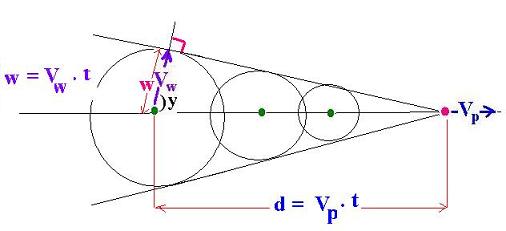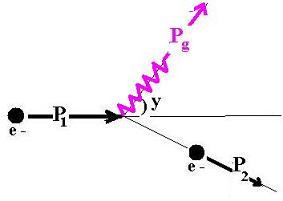CERENKOV EFFECT
Let' consider a charged particle of velocity Vp
incident in a transparent medium.
This particle emits photons in the "y" direction. Furthermore,
the incident charged particle recoils.

The emitted photon propagates with a speed Vw through the
medium. If the refraction index medium is n then the velocity
Vw is not equal c ( speed of light in the vacuum) but tp c/n; that is
the speed of light in that medium. Let's write:
Vw = c/n (1)
We consider a high-energy charged particle, that has
a velocity greater than Vw. The related Cerenkov radiation
is a chok wave.
At first, we can quickly write the following relationship, by
solving for the angle y, we have
cos y = Vw/Vp (2)
or cos y = c/n.Vp
We know that "y" could not exist if its cosine is
greater than 1 ( or less than -1) :
cos y = 1 gives Vp = Vw = c/n
cos y greater than 1 : Vw greater than Vp : No radiation any more.
The threishold to have this emitted radiation is then:
Vparticule = c/n
Now, let's find the true relationship relating to cos a.
Consider the following reaction:

Where the electron is traveling through the medium and
gives a photon and a recoil electron.
The following figure shows the mechanism:

Let's do the following calculations:
Write that the liear momentum and the energy
of this system are both concerved in the relativistic
context. We will use the following factor:
 with g1 = g(V1) and g2 = g(V2)
And the relation:
E0= m0c2 for the rest mass (3)
with g1 = g(V1) and g2 = g(V2)
And the relation:
E0= m0c2 for the rest mass (3)
Before the electron enters the medium
The incident electron had:
P1 : for the liear momentum.
E1: for the total energy, with E1 = m 1c2
where m1 = g1m0
Or
E12 = P12 c2 + m02c4(4)
While the electron is traveling inside the medium:
The electron has:
P2 : for the liear momentum.
E2: for the total energy, with E2 = m 2c2
where m2 = g2m0
Or
E22 = P22 c2 + m02c4 (5)
The photon has:
Pg : for the liear momentum. Its magnitude is p g = hN/c
( h : Planck constant, N the frequency of the emitted radiation, and c the speed
of light in the vaccum)
Because the emitted photon is moving through the
medium of refraction index equal to n, we have:
pg= hN/(c/n) (6)
Eg = hN: for its total energy.
The conservation of the momentum is:
P1 + P2 = Pg (7)
hence:
P2 = Pg - P1
Or:
p2 2 = pg2 + p12 - 2.p1 pg cos y (8)
The conservation of energy is:
E1 = Eg + E2
That is:
P12 c2 + m02c4 = hN + P22 c2 + m02c4
Using the relation (8) :
(P12 c2 + m02c4) 1/2 - hN = (g2 + p12 - 2.p1 pg cos y + m02c4 )1/2 (9)
Hence, using (6)
cos y = (2hN.(P12 c2 + m02c4) 1/2 + ( n2 - 1)h2N2)/2c2p1p2 (10)
We have :
p1 = g1m0V1
Substituting this relation into (10), we get:
cos y = c/nV1 + (n2- 1) hN/2nc2g1m0V1
Or :
cos y = c/nV1 + ((n2 -1 ). hN (c2 - V2)1/2 )/(2ncm02V1)

|

